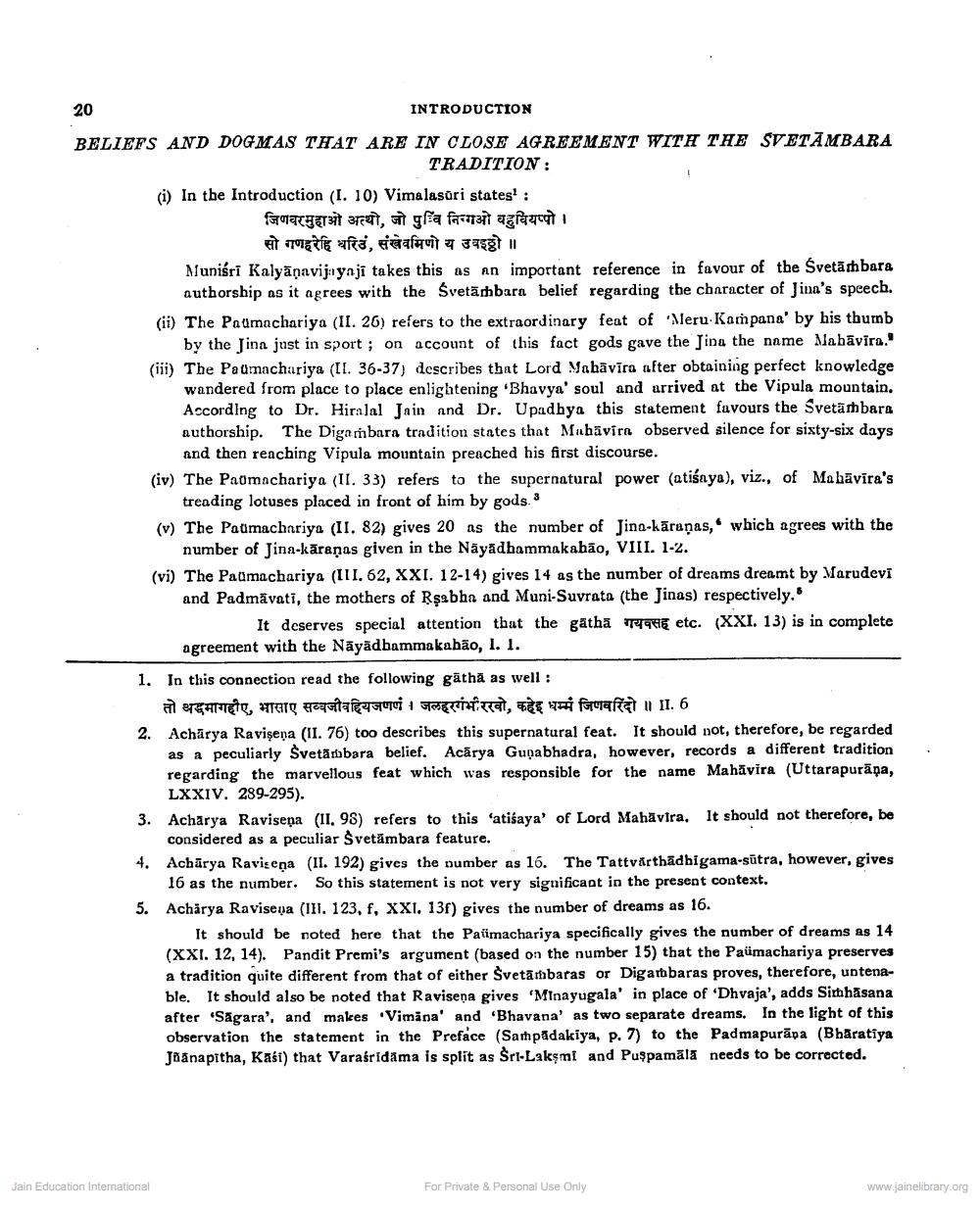________________
20
INTRODUCTION
BELIEFS AND DOGMAS THAT ARE IN CLOSE AGREEMENT WITH THE SVETĀMBARA
TRADITION : (i) In the Introduction (I. 10) Vimalasäri states :
जिणवरमुहाओ अत्थो, जो पुग्वि निन्गओ बहुवियप्पो ।
सो गणहरेहि धरिलं, संखेवमिणो य उवइछो॥ Muniśri Kalyāņavijaiyaji takes this as an important reference in favour of the Svetārbara
authorship as it agrees with the Svetāmbara belief regarding the character of Jina's speech. (ii) The Padmachariya (II. 26) refers to the extraordinary feat of Meru. Kampana' by his thumb
by the Jina just in sport ; on account of this fact gods gave the Jina the name Mabāvīra." (iii) The Paumachariya (IL. 36-37) describes that Lord Mabāvīra after obtaining perfect knowledge
wandered from place to place enlightening Bhavya' soul and arrived at the Vipula mountain, According to Dr. Hiralal Jain and Dr. Upadhya this statement favours the Svetārbara authorship. The Digambara tradition states that Mabāvira observed silence for sixty-six days
and then reaching Vipula mountain preached his first discourse. (iv) The Paomachariya (II. 33) refers to the supernatural power (atiśnya), viz., of Mahavira's
treading lotuses placed in front of him by gods. (v) The Paumachariya (II. 82) gives 20 as the number of Jina-kāraņas, which agrees with the
number of Jina-kāraṇas given in the Nāyādhammakabão, VIII. 1-2. (vi) The Padmachariya (III. 62, XXI. 12-14) gives 14 as the number of dreams dreamt by Marudevi and Padmavati, the mothers of Rşabha and Muni-Suvrata (the Jinas) respectively,
It deserves special attention that the gatha T9h etc. (XXI. 13) is in complete agreement with the Nāyādhammakabão, l. 1.
1. In this connection read the following gātha as well : ___तो बदमागहीए, भासाए सव्वजीवहियजणणं । जलहरगंभीररवो, कहेइ धम्म जिणवरिंदो ॥ II. 6 2. Achārya Ravişena (11.76) too describes this supernatural feat. It should not, therefore, be regarded
as a peculiarly Svetärbara belief. Acārya Gupabhadra, however, records a different tradition regarding the marvellous feat which was responsible for the name Mahāvira (Uttarapurāņa,
LXXIV. 289-295). 3. Acharya Ravisena (II, 98) refers to this fatisaya' of Lord Mahāvira. It should not therefore, be
considered as a peculiar Svetămbara feature. 4. Acharya Ravisena (II. 192) gives the number as 16. The Tattvarthadhigama-sūtra, however, gives
16 as the number. So this statement is not very significant in the present context. 5. Acharya Ravisena (III. 123, f, XXI, 13f) gives the number of dreams as 16.
It should be noted here that the Paümachariya specifically gives the number of dreams as 14 (XXI. 12, 14). Pandit Premi's argument (based on the number 15) that the Paümachariya preserves a tradition quite different from that of either Svetambaras or Digambaras proves, therefore, untenable. It should also be noted that Ravisena gives 'Minayugala' in place of 'Dhvaja', adds Simhasana after Sagara', and makes Vimana' and 'Bhavana' as two separate dreams. In the light of this observation the statement in the Preface (Satpadakiya, p. 7) to the Padmapurāpa (Bharatiya Janapitha, Kasi) that Varasridima is split as Sri-Laksmi and Puspamala needs to be corrected.
Jain Education International
For Private & Personal Use Only
www.jainelibrary.org




